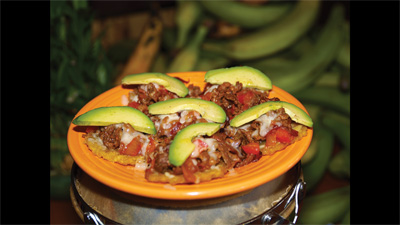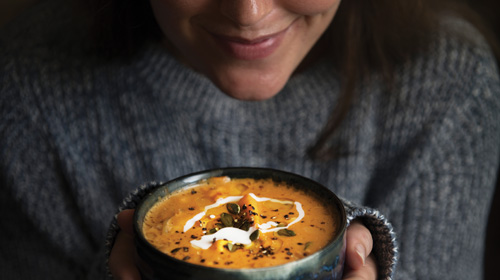International flavors from around the world right in your own backyard
America is a melting pot of ethnicities, and the diversity of our country makes for fabulous dining experiences. Whenever an immigrant arrives in the U.S., one of the many traits shared with other newcomers is a craving for the foods they’ve left behind. Their bags are often filled with vibrant spices from their homelands and seeds from the plants they need to recreate the dishes made from recipes passed down from their ancestors.
The North Bay is a place where restaurateurs can source some of the world’s finest ingredients, the sweetest organic apples, heirloom tomatoes in all shapes and colors, grass-fed beef and exotic coastal cheeses. These days, restaurants offer a fusion of foods that no one would have thought to combine a few decades ago. Thai chicken pizza, Korean tacos, southwestern egg rolls. The seemingly strange concoctions end up being delicious, and the possibilities endless. Yet, as tasty as these new culinary pleasures might be, sometimes it’s good old-fashioned home cooking that hits the epicurean spot. Four North Bay ethnic restaurants have authenticity in mind when it comes to creating the food that makes their customers return for more and share one quality in common. All of them feature at least one family recipe from their dadee ma, seti ayati, abuela or mormor. (Indian, Ethiopian, Spanish and Swedish words for grandmother.)
South Asian spices in Napa
The Indian proverb “Garlic is as good as 10 mothers” indicates just how important flavor is to Indian cuisine. Harjeet Bhangoo, the owner of Aroma Indian Cuisine in Napa, delivers a freshly made lunch to his son at school each day. Family is a priority, as is the quality of the food his family eats. The lunch buffet at Napa’s only Indian restaurant offers a variety of fragrant menu items. A slow-cooked goat curry is succulent and tender. The unique flavor of goat is captured beautifully with the spices and cooking technique, resulting in a deep and balanced tasting experience. The kadri okra is so earthy and complex that it makes Bhangoo’s customers reach for another bite before the thought of putting their fork down ever enters their minds.
Bhangoo speaks passionately about the restaurant and the authenticity of the food, but he’s clear to state that the food he serves goes beyond only satisfying one’s hunger. “My life’s aim is to cook to the level of healing people’s souls and minds,” says Bhangoo. “We prepare our food the ‘root’ way, the way that it is traditionally done. We take our time, we don’t take any short-cuts, but let the process, and the temperature/heat and time do its work to produce the flavors.” Bhangoo expands on the powers of cooking that reach beyond placating hunger. “It’s a bit of a hobby of mine to explore the powers of herbs and spices and ensure that our dishes not only satisfy your hunger, but that the flavors and healing powers of the ingredients put you in a better place than when you walked into the restaurant.”
Amongst all the herbs and spices used at Aroma Indian Cuisine (turmeric, cloves, cumin, cayenne, anise, cardamom, and many more), Bhangoo admits he uses cloves and licorice (anise and star anise) in his dishes, as they are good for your stomach. The herbs he works with and the traditional healing methods are known in India to help with certain conditions. Bhangoo was born in India and went to high school there. Food and cooking didn’t always have the ardent hold on him that it does today. Though the historic elements of cooking, the cultural aspects of food preparation and how cooking seemingly permeates time started to catch his interest many years ago. “Magic happens every day. I think about herbs, spices, blends, and flavors all the time. Time permitting, I watch food documentaries on TV. I think about food all of the time,” says Bhangoo.
What makes it fun for him to go to work every day? Bhangoo revels in the fact that his food makes his customers happy. “One evening I was cooking in the kitchen and we had a birthday party for a boy in one of our private dining rooms,” he recalls. “As I was out in the hallway, some of the kids were walking toward me, they must have concluded that I was the chef, apron and all, and they all stopped and started clapping.”
Flavors from The Island of Enchantment
“We are hoping that Jennifer Lopez will visit the restaurant, but so far we’ve had one of her exes, Chris Judd, dine with us,” says Jacqueline Roman with a big smile on her face as she offers up Mofongo, one of the signature appetizers at El Coqui Puerto Rican Cuisine in Santa Rosa. The twice-fried plantain and pork belly dish is served in a soothing broth. The salty crispy pork, sweetness of the plantain and herbs and spices of the sofrito, together with the contrasting textures, makes for a spectacular tasting experience. Sofrito is a base used extensively in Puerto Rican cuisine. “If your grandmother is Italian, her base is ragu. If she’s Puerto Rican, she uses sofrito,” says Roman. With a creole influence, the sofrito is tomato based and further flavored with bell peppers, cilantro, cumin, and many other herbs and spices. Even the beans and the rice are slow cooked and marinated in sofrito.
 Roman and her business and life partner, Tina Jackson, found themselves at a crossroads a little more than a decade ago. Roman was a furniture storeowner, while Jackson held a sales job in banking. Given the volatility of the economy at the time, and the insecurity of their jobs, they asked themselves what they were good at, then thought about how they could leverage their skills so they could make a living. They also wanted to have some fun in the process. “Our thinking at the time when we were assessing our options and leaning towards opening an authentic Puerto Rican restaurant, was that we don’t have very much to loose. We’re good at entertaining, and we’re good at cooking, so let’s give that a shot,” says Jackson. El Coqui’s grand opening took place in June 2009 and with a 10-year anniversary on the horizon, they plan to celebrate their success in style.
Roman and her business and life partner, Tina Jackson, found themselves at a crossroads a little more than a decade ago. Roman was a furniture storeowner, while Jackson held a sales job in banking. Given the volatility of the economy at the time, and the insecurity of their jobs, they asked themselves what they were good at, then thought about how they could leverage their skills so they could make a living. They also wanted to have some fun in the process. “Our thinking at the time when we were assessing our options and leaning towards opening an authentic Puerto Rican restaurant, was that we don’t have very much to loose. We’re good at entertaining, and we’re good at cooking, so let’s give that a shot,” says Jackson. El Coqui’s grand opening took place in June 2009 and with a 10-year anniversary on the horizon, they plan to celebrate their success in style.
“Jackie was born in New York. Every summer as a child, she went to live with her grandmother in the  rainforest of Puerto Rico,” says Jackson. Roman not only enjoyed her time in Puerto Rico with her abuela but says, “My only inheritance were my grandmother’s recipes.” To Roman and Jackson, authenticity in the cuisine is simply cooking the dishes that Roman’s grandmother taught her to make with the same attention to detail and love. “Honoring history and honoring tradition,” Roman says. The pride in her voice is unmistakable, and judging by the popularity of the restaurant, her abuela’s authentic Puerto Rican food stands up to the test of time.
rainforest of Puerto Rico,” says Jackson. Roman not only enjoyed her time in Puerto Rico with her abuela but says, “My only inheritance were my grandmother’s recipes.” To Roman and Jackson, authenticity in the cuisine is simply cooking the dishes that Roman’s grandmother taught her to make with the same attention to detail and love. “Honoring history and honoring tradition,” Roman says. The pride in her voice is unmistakable, and judging by the popularity of the restaurant, her abuela’s authentic Puerto Rican food stands up to the test of time.
“Talking to the customers about Puerto Rico, the culture, the history, and, of course, the food never gets old. There is no motivation like when a customer is brought to tears as the food brings back memories, bridging time and geography. In my book, that is as much of a definition of ‘authentic’ as any other,” says Roman.
A Taste of Africa in downtown Santa Rosa
Abyssinia restaurant first opened its doors to the public 12 years ago and has been serving food from Ethiopia ever since. Abyssinia is family owned and operated under the guidance and leadership of Wodi Merso, the family matriarch. Wodi and her son, Nahome Asfaha, make up the core of the team, but there are many contributors, including Asfaha’s niece, Menen Michael. Michael mentions that she is a big fan of Marcus Samuelsson, the famous Scandinavian chef from Ethiopia. She has great admiration for his skills and the passion that he applies to his cooking, but she’s most pleased that Samuelsson (better known for his pickled herring than African cuisine) is a proud ambassador of his Ethiopian heritage.
Spend a few minutes with Asfaha at the restaurant, and it becomes abundantly clear that authenticity is important to him. Not only in the final product on the table, but in all the methods and traditions of preparing the dishes handed down in his family from generation to generation. “In order to achieve the authentic flavor of the dish, you have to follow the traditional method of cooking. Everything we serve here is made from scratch, by hand, with no shortcuts.”
Most of the dishes are served on a single piece of round Ethiopian bread called injera, along with a warm towel to cleanse your hands. The traditional way to eat Ethiopian food is with the injera as an edible scooper, though cutlery is offered. The injera is spread across a small platter, and an assortment of sides such as red and green lentils, greens, cabbage, potatoes and carrots are placed on the bread along with the entrée. A separate plate containing additional pieces of injera is served on the side. If you choose the traditional method of eating, moist towelettes are available.
The matriarch, Merso, comes from a noble family in the Wollo region of Ethiopia, where the family tree includes some prominent and powerful figures. “Being a woman from a noble family, my mother was expected to be fully skilled in all traditional standards and that included making the best food, the best drinks, and otherwise knowing how to implement other practices that are important in Ethiopia and in her region. What we serve at Abyssinia is exactly what we would serve if the restaurant were located in my mother’s place of birth,” says Asfaha. Ethiopian food is labor intensive to make. At Abyssinia, they boil all of the grains themselves and blend their own spices. “We are particular with the spices we use and every detail in the food preparation is done the way that my mother was taught to prepare food in Ethiopia.” Asfaha explains that many of the dishes on the menu are typically reserved for more celebratory events in Ethiopia, such as weddings and holidays. But these special dishes are now available for their customers to enjoy on a regular basis.
Modern and traditional Swedish delights
Stockhome in Petaluma exudes a modern Scandinavian flair from the moment you walk in the door. A bright space, right off the main strip made famous by the film American Graffiti, the counter-service style restaurant offers a few well-known Scandinavian dishes along with contemporary Swedish creations at reasonable prices. Husband-and-wife team Roberth and Andrea Sundell had already been owners of PLÄJ for six years, when they opened a more casual restaurant in Petaluma where they were raising their family. Running PLÄJ, the only Nordic fine dining experience in San Francisco, was exciting and satisfying but what the Sundells wanted to do next was to create something interesting and fun closer to home.
“We wanted to have a restaurant that featured all of the foods that we couldn’t wait to eat whenever we arrived in Sweden,” Andrea says. Though she easily could be mistaken for Scandinavian with her beautiful blue eyes and blond hair, Roberth is the Swedish chef who hails from one of the lands of the midnight sun. The foods that the family craves most when they visit his homeland are modern street foods. With an influx of immigrants from Iran, Iraq, Lebanon and Syria, Turkish-based foods have become the go-to fast eats in Sweden.
 “Introducing food from different cultures is a challenge. When people immigrate and open eateries, they adapt the food of their country in a way that makes it more appealing to the residents of their new country,” says Roberth. As a chef in Sweden, he saw how the food scene evolved as the ethnic diversity of the country grew. “Our kebobs are not like the kebobs you’d get at a Turkish restaurant,” says Andrea, who runs the front of the house. “Our food is like the Turkish food with a twist that you’d get in Stockholm.”
“Introducing food from different cultures is a challenge. When people immigrate and open eateries, they adapt the food of their country in a way that makes it more appealing to the residents of their new country,” says Roberth. As a chef in Sweden, he saw how the food scene evolved as the ethnic diversity of the country grew. “Our kebobs are not like the kebobs you’d get at a Turkish restaurant,” says Andrea, who runs the front of the house. “Our food is like the Turkish food with a twist that you’d get in Stockholm.”
Stockhome has had a few Scandinavian customers who come to dine, but were slightly disappointed to find only a few of the traditional dishes they recognized. However, younger patrons who had recently lived in or visited Sweden recognized all of the dishes. For purists, there’s no comfort food more recognizable than Swedish meatballs. The ones you’ll get at Stockhome are not the kind you get from Ikea. The big, juicy, round spheres of goodness are made from Roberth’s grandmother’s recipe. Served with mashed potatoes, perfectly seasoned gravy and a traditional lingdonberry sauce, the meatballs are a crowd pleaser for both young and old.
But it’s not just savory traditions that are featured at Stockhome. “Sweden is one of the world’s largest producers of candy. We are also one of the biggest consumers of candy,” says Roberth. When Roberth moved permanently to the U.S. after marrying Andrea, his mother often sent packages filled with his favorite candies. Andrea, knowing how good Swedish candy is, thought it would be nice to have a candy counter in the restaurant. The counter, loaded with first-class sweets, features a variety of Scandinavian candies including soft gummies in different flavors, a diverse selection of car shaped candies, chocolates and something uniquely suited to Scandinavian palates: spicy and salty black licorice. The idea turned out to be as popular as Andrea had hoped it would be. Says Roberth, “We were surprised to see how much fun families had when they came in to eat and couldn’t wait to finish dinner so they could fill their candy bags.”
The Sundell’s are not only happy to be working closer to home but are glad to have the opportunity to give back to their city. They sell jewelry and other goods made by local artisans at Stockhome and also employ a number of high school students. “For many, it’s their first job and for us it’s a way to invest in our community by providing on- the-job training, teaching the students about work ethic and giving them a positive first employment experience,” says Roberth. During the 2018 holiday season, Stockhome hosted a traditional Julebord, with all three seatings of 50 selling out. The Sundells will be hosting an Easter Buffet in April and are prepared for another successful event.
Hunger to succeed
Aroma, El Coqui, Abyssinia and Stockhome all brought food culture from another land and transformed their dishes into North Bay staples. Their passion for food carries them through the daily difficulties of operating a restaurant. Though each establishment has its own story of creation, they all had confidence their cuisine would catch on as it has. “You have to take chances in life,” says Roberth Sundell. “I worked hard for everybody else, so I knew I would work hard for myself, and it worked out.”




